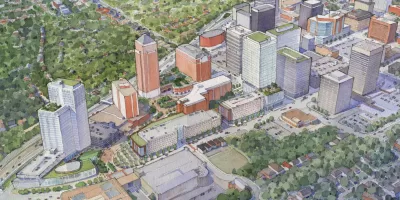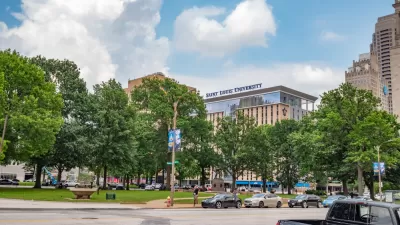The rare and elusive comprehensive planning review has been published by nextSTL.

Alex Ihnen critiques the plan for the proposed, $771.8 million Centene Clayton corporate campus, which recently had another in a series of well-attended public hearings. Ihnen writes the following preamble before launching into a comprehensive evaluation of the plans merits and demerits:
To premise the following critique, it needs to be conceded that the plan to develop vacant lots, and low-rise buildings into office towers in downtown Clayton is a good one. It’s better than good, it’s great. It has been an absurd sight as large swaths of vacant land have sat idle for a decade next to the region’s high-end business center, two MetroLink stations, and a Ritz-Carlton hotel. The $770M plan to add nearly 3,000 employees, residents, and retail to the city’s central business district is something to applaud.
Among the weaknesses of the plan, as evaluated by Ihnen, are the plan's effects on the street. "The design…completely abandons Hanley [Road] as a place for pedestrians," for instance, writes Ihnen. Moreover, "the campus master plan for employee circulation works hard to keep everyone inside, from garage to office and across the campus."
Another criticism posited by Ihnen: the need to increase the number of residential units proposed by the plan, to reduce traffic to the campus by allowing more people to live within walking distance. The plan has only taken steps in the opposite direction, according to Ihnen, decreasing from 135 to 119 in recent drafts.
Other themes of Ihnen's critique include public spaces, architecture, and NIMBYs. On that last count, Ihnen takes issue with "misplaced at best" criticisms by the opposition to the development.
FULL STORY: How Centene’s $770M Clayton Corporate Campus Project and NIMBY Opposition Fall Short

Study: Maui’s Plan to Convert Vacation Rentals to Long-Term Housing Could Cause Nearly $1 Billion Economic Loss
The plan would reduce visitor accommodation by 25,% resulting in 1,900 jobs lost.

North Texas Transit Leaders Tout Benefits of TOD for Growing Region
At a summit focused on transit-oriented development, policymakers discussed how North Texas’ expanded light rail system can serve as a tool for economic growth.

Why Should We Subsidize Public Transportation?
Many public transit agencies face financial stress due to rising costs, declining fare revenue, and declining subsidies. Transit advocates must provide a strong business case for increasing public transit funding.

How to Make US Trains Faster
Changes to boarding platforms and a switch to electric trains could improve U.S. passenger rail service without the added cost of high-speed rail.

Columbia’s Revitalized ‘Loop’ Is a Hub for Local Entrepreneurs
A focus on small businesses is helping a commercial corridor in Columbia, Missouri thrive.

Invasive Insect Threatens Minnesota’s Ash Forests
The Emerald Ash Borer is a rapidly spreading invasive pest threatening Minnesota’s ash trees, and homeowners are encouraged to plant diverse replacement species, avoid moving ash firewood, and monitor for signs of infestation.
Urban Design for Planners 1: Software Tools
This six-course series explores essential urban design concepts using open source software and equips planners with the tools they need to participate fully in the urban design process.
Planning for Universal Design
Learn the tools for implementing Universal Design in planning regulations.
City of Santa Clarita
Ascent Environmental
Institute for Housing and Urban Development Studies (IHS)
City of Grandview
Harvard GSD Executive Education
Toledo-Lucas County Plan Commissions
Salt Lake City
NYU Wagner Graduate School of Public Service





























